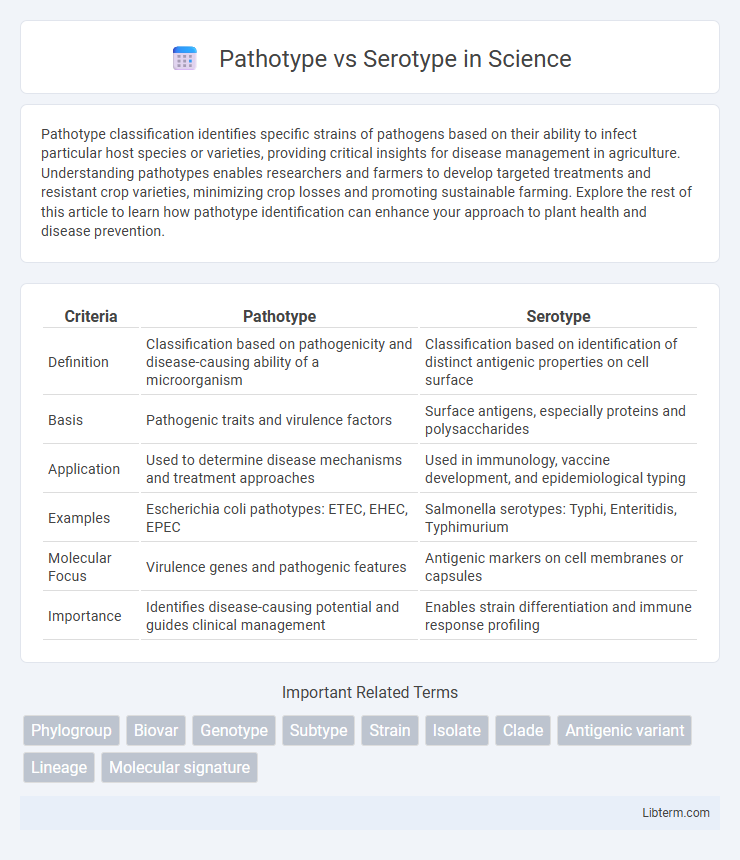Pathotype classification identifies specific strains of pathogens based on their ability to infect particular host species or varieties, providing critical insights for disease management in agriculture. Understanding pathotypes enables researchers and farmers to develop targeted treatments and resistant crop varieties, minimizing crop losses and promoting sustainable farming. Explore the rest of this article to learn how pathotype identification can enhance your approach to plant health and disease prevention.
Table of Comparison
| Criteria | Pathotype | Serotype |
|---|---|---|
| Definition | Classification based on pathogenicity and disease-causing ability of a microorganism | Classification based on identification of distinct antigenic properties on cell surface |
| Basis | Pathogenic traits and virulence factors | Surface antigens, especially proteins and polysaccharides |
| Application | Used to determine disease mechanisms and treatment approaches | Used in immunology, vaccine development, and epidemiological typing |
| Examples | Escherichia coli pathotypes: ETEC, EHEC, EPEC | Salmonella serotypes: Typhi, Enteritidis, Typhimurium |
| Molecular Focus | Virulence genes and pathogenic features | Antigenic markers on cell membranes or capsules |
| Importance | Identifies disease-causing potential and guides clinical management | Enables strain differentiation and immune response profiling |
Understanding Pathotype: Definition and Significance
Pathotype refers to a classification of pathogens based on their ability to cause disease in specific host organisms, highlighting variations in virulence and host interactions. Understanding pathotype is crucial for developing targeted treatments and effective disease management strategies in agriculture and medicine. This classification differs from serotype, which is based on distinct antigenic properties of pathogens identified by immune responses.
Exploring Serotype: Definition and Importance
Serotype refers to a distinct variation within a species of bacteria or viruses, classified based on differences in surface antigens, such as lipopolysaccharides or capsular polysaccharides. Identifying serotypes is crucial for epidemiological tracking, vaccine development, and understanding immune responses, as different serotypes can cause varying disease manifestations and transmission dynamics. Serotyping enables precise diagnosis and targeted treatment strategies by distinguishing between strains with unique pathogenic potentials.
Key Differences Between Pathotype and Serotype
Pathotype refers to the classification of microorganisms based on their pathogenic mechanisms and the diseases they cause, highlighting virulence factors and host interactions. Serotype is defined by the distinct variations in surface antigens, such as proteins or polysaccharides, that elicit specific immune responses in the host. Key differences include pathotype emphasizing disease-causing properties and clinical effects, while serotype focuses on antigenic diversity used for immune recognition and epidemiological tracking.
Classification Methods for Pathotypes
Pathotypes are classified based on their pathogenic traits and the specific symptoms they cause on host plants, using methods such as host range testing, virulence assays, and molecular markers that identify genes responsible for pathogenicity. Serotypes, in contrast, are classified through immunological techniques that detect variations in surface antigens, like agglutination tests and enzyme-linked immunosorbent assays (ELISA). Advanced genomic sequencing enhances pathotype classification by revealing genetic differences linked to host specificity and infection mechanisms.
Techniques for Serotyping Microorganisms
Serotyping microorganisms involves identifying distinct variations within species based on their surface antigens using techniques such as agglutination assays, enzyme-linked immunosorbent assay (ELISA), and molecular methods like PCR-based serotyping. Agglutination assays utilize specific antisera to detect antigen-antibody reactions, enabling rapid serovar classification. PCR-based methods target serotype-specific genetic markers, providing higher sensitivity and specificity compared to traditional serological techniques.
Role of Pathotypes in Disease Mechanisms
Pathotypes classify pathogens based on their specific mechanisms of causing disease, highlighting how they interact with host cells and evade immune responses. Unlike serotypes, which are differentiated by surface antigens and immune system recognition, pathotypes provide insights into virulence factors, infection strategies, and disease progression. Understanding pathotypes enables targeted therapeutic approaches by revealing molecular pathways essential for pathogen survival and host damage.
Serotypes and Their Impact on Epidemiology
Serotypes are distinct variations within a species of bacteria or viruses, differentiated by their unique surface antigens, which play a critical role in pathogen identification and immune response. In epidemiology, serotyping helps track the spread of infectious diseases, identify outbreak sources, and guide vaccine development by targeting specific serotypes prevalent in populations. The accurate classification of serotypes enables effective public health interventions and improves understanding of pathogen diversity and evolution.
Pathotype vs Serotype: Applications in Diagnostics
Pathotype classification identifies microorganisms based on their pathogenic mechanisms and disease-causing potential, essential for pinpointing infection sources and tailoring treatment strategies. Serotype differentiation relies on distinct surface antigens, facilitating epidemiological tracking and vaccine design. Combining pathotype and serotype analyses enhances diagnostic precision, enabling targeted therapeutic interventions and improved disease management.
Implications for Vaccine Development
Pathotype classification identifies pathogens based on their virulence mechanisms and disease-causing capabilities, which directly influences the selection of vaccine targets for effective immunity. Serotype focuses on distinguishing strains by their surface antigens, guiding vaccine design to elicit specific antibody responses against prevalent serotypes. Understanding both pathotype and serotype diversity is crucial for developing broad-spectrum vaccines that provide cross-protection against multiple strains and reduce the risk of vaccine escape variants.
Future Directions in Pathotype and Serotype Research
Future directions in pathotype and serotype research emphasize integrating genomic sequencing and bioinformatics to enhance pathogen classification accuracy and outbreak tracking. Advances in machine learning algorithms enable predictive modeling of virulence factors and immune responses based on serotype and pathotype data. Emerging technologies, such as CRISPR-based diagnostics, promise rapid identification of specific pathotypes and serotypes, improving clinical decision-making and targeted therapeutics.
Pathotype Infographic

 libterm.com
libterm.com